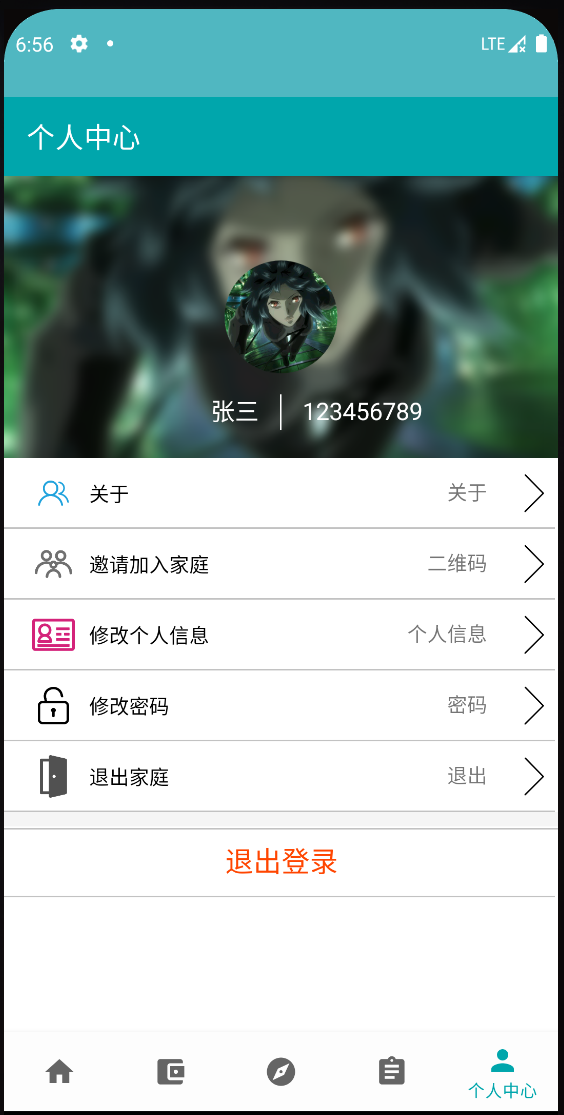android 家庭分享 [HomeHelper]
一. 简介
本项目为了解决家庭成员在生活中帐目信息不能同步,家庭备忘录不同步的问题,并且有一定的互动功能
1.1. HomeHelper 家庭帮手 特点
- :chart_with_upwards_trend:家庭记账,和分析近期情况,并且能家庭同步
- :golf:同步分享动态
- :ledger:同步家庭备忘录
- :closed_lock_with_key: 二维码分享加入家庭,且token校验
1.2. 界面展示
- 主界面

- 个人中心

1.3. 使用的技术栈
Android jetpackRoom数据库的ORM框架LiveData动态刷新页面ViewModel保存页面数据,用其维护数据kotlinx.coroutines协程, io操作在协程中运行, 防止阻塞ui线程retrofit2和OkHttp2和后台发送网络请求- 后台使用
spring bootspring security开发的api, 以及安全验证功能
二. 主要功能介绍
2.1. 添加帐单并同步
- 记账
- 同步家庭帐单
- 通过折线图统计近期家庭帐单信息
2.2. 扫描二维码加入家庭
- 二维码分享
- 扫描二维码加入家庭
2.3. 备忘录添加并同步
- 同步备忘录,
- 家庭成员都能看到备忘录
2.4. 分享功能
- 分享近期的动态(表情,图片,回复)
三. 主要功能逻辑实现
3.1. 登陆功能 api-android.ghovos.top/user/login
1 | @startuml |
3.2. 注册功能 api-android.ghovos.top/user/regist
- 大致流程与登陆相同, 但是要判断用户名是否重复
3.3. 二维码分享加入家庭 api-android.ghovos.top/user/join_family
1 | @startuml |
3.4. 同步功能(以帐单为例)api-android.ghovos.top/user/syn_family
1 | @startuml |
3.5. 头像上传功能
- 本地读取图片, 通过api上传端后台
- 后台将图片存入oss, 加速图片访问
四. 页面部分
4.1 RecycleView 和 LiveData配合使用
1 | <!-- example --> |
- 通过自定义adapter ,设置view的数据, 以及 因为有livedata,数据可以实时自动刷新
1
2
3
4
5
6
7
8
9
10viewModel.getLiveData()
?.observe(viewLifecycleOwner, { memorandumList: List<Memorandum> ->
memorandum_recycle_view.adapter =
MemorandumAdapter(
ctx,
memorandumList,
viewModel,
)
memorandum_recycle_view.layoutManager = LinearLayoutManager(activity)
})
4.2 Fragment
- 在MainActivity中使用Fragment
- 多个页面在Activity中嵌套切换
1
2
3
4
5
6
7//底部导航栏绑定
bottomNavigationView = findViewById(R.id.bottomNavigationView)
navHostFragment = supportFragmentManager.findFragmentById(R.id.fragment) as NavHostFragment
navController = navHostFragment.navController
configuration = AppBarConfiguration.Builder(bottomNavigationView.menu).build()
NavigationUI.setupActionBarWithNavController(this, navController, configuration)
NavigationUI.setupWithNavController(bottomNavigationView, navController)
五. 功能主要代码实现
5.1. 网络部分
添加网络权限
1
<uses-permission android:name="android.permission.INTERNET" />
使用retrofit 封装不同的请求
1
2
3
4
5/**
* example
*/
suspend fun syn( accountList: List<AccountTdo>): BaseResponse<List<AccountTdo>>创建retrofit对象
1
2
3
4
5
6
7
8
9
10
11
12
13
14
15
16
17
18
19
20
21
22
23
24/**
* example
* 通过 retrofit 网络发送请求
*/
object UserApi {
private val gsonFormat = GsonBuilder().setDateFormat("yyyy-MM-dd HH:mm:ss").create()
private val api by lazy {
val retrofit = Retrofit.Builder()
.addConverterFactory(GsonConverterFactory.create(gsonFormat))
.client(
OkHttpClient
.Builder()
.addInterceptor(MyIntercept())
.build()
)
.build()
retrofit.create(UserService::class.java)
}
fun get(): UserService {
return api
}
}retrofit异常处理
1
2
3
4
5
6
7
8
9
10
11
12
13
14
15
16
17
18
19
20
21
22
23
24
25
26
27
28
29
30
31
32
33
34
35
36
37
38
39
40
41
42
43
44
45
46
47suspend inline fun <T> apiCall(crossinline call: suspend CoroutineScope.() -> BaseResponse<T>): BaseResponse<T> {
return withContext(Dispatchers.IO) {
val res: BaseResponse<T>
try {
res = call()
} catch (e: Throwable) {
Log.e("ApiCaller", "request error", e)
// 请求出错,将状态码和消息封装为 ResponseResult
return@withContext ApiException.build(e).toResponse<T>()
}
if (res.code == ApiException.CODE_AUTH_INVALID) {
Log.e("ApiCaller", "request auth invalid")
// 登录过期,取消协程,跳转登录界面
// 省略部分代码
cancel()
}
return@withContext res
}
}
// 网络、数据解析错误处理
class ApiException(
private val code: Int,
override val message: String?,
override val cause: Throwable? = null
) : RuntimeException(message, cause) {
companion object {
// 网络状态码
const val CODE_NET_ERROR = 4000
const val CODE_TIMEOUT = 4080
const val CODE_JSON_PARSE_ERROR = 4010
const val CODE_SERVER_ERROR = 5000
// 业务状态码
const val CODE_AUTH_INVALID = 401
fun build(e: Throwable): ApiException {
/**
* 各种异常 不同处理
*/
}
}
fun <T> toResponse(): BaseResponse<T> {
return BaseResponse(code, message)
}
}后端和安卓端之间传递数据用json
5.2. 数据库部分
创建实体
AccountUserMemorandum编写数据库查询语句 dao
1
2
3
4
5
6/**
* 获取所有数据的列表
* @return LiveData 实时数据 不用在新的线程执行
*/
fun getAll(): LiveData<List<Account>>用单例模式创建数据库
1
2
3
4
5
6
7
8
9
10
11
12
13
14
15
16
17
18
19
20
21/**
* 单例模式
*/
companion object {
private var INSTANCE: FamilyShareDatabase? = null
private val applicationScope = CoroutineScope(SupervisorJob())
fun getInstance(context: Context): FamilyShareDatabase = INSTANCE ?: synchronized(this) {
INSTANCE ?: buildDatabase(context).also { INSTANCE = it }
}
private fun buildDatabase(context: Context) =
Room.databaseBuilder(
context.applicationContext,
FamilyShareDatabase::class.java,
"family_share_db"
).addCallback(UserDatabaseCallback(applicationScope)) // 加入callback
.build()
}调用数据库例子
1
2
3
4
5
6
7
8
9
10suspend fun getUserById(id: Long) = withContext(viewModelScope.coroutineContext) {
userDao?.getUserById(id)
}
/**
* 协程中调用
*/
GlobalScope.launch{
getUserById(1)
}
为了性能,数据库的增删改查都在新的协程执行
All articles in this blog are licensed under CC BY-NC-SA 4.0 unless stating additionally.


![android 家庭分享 [HomeHelper]](https://oss.ghovos.top/hexo-blog/android-cover.png)